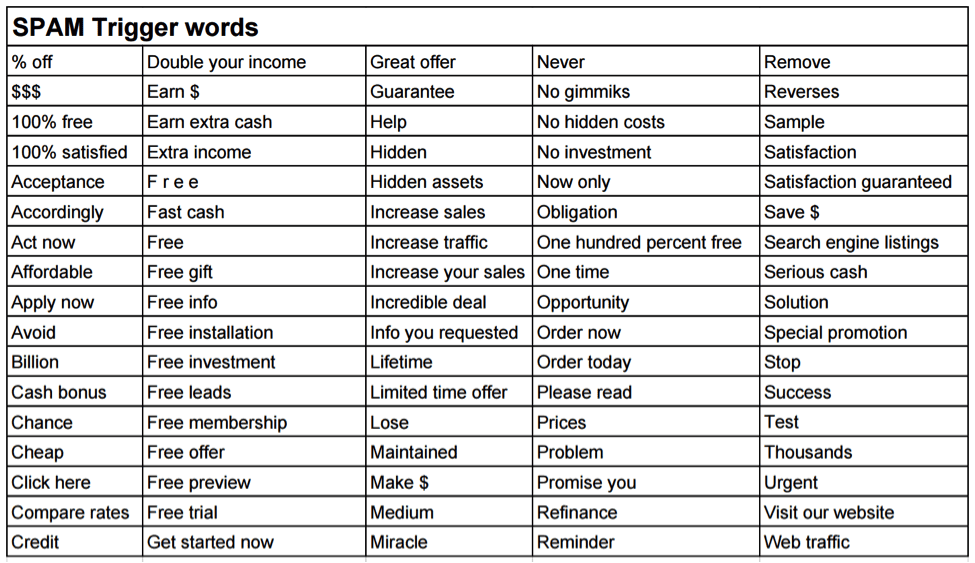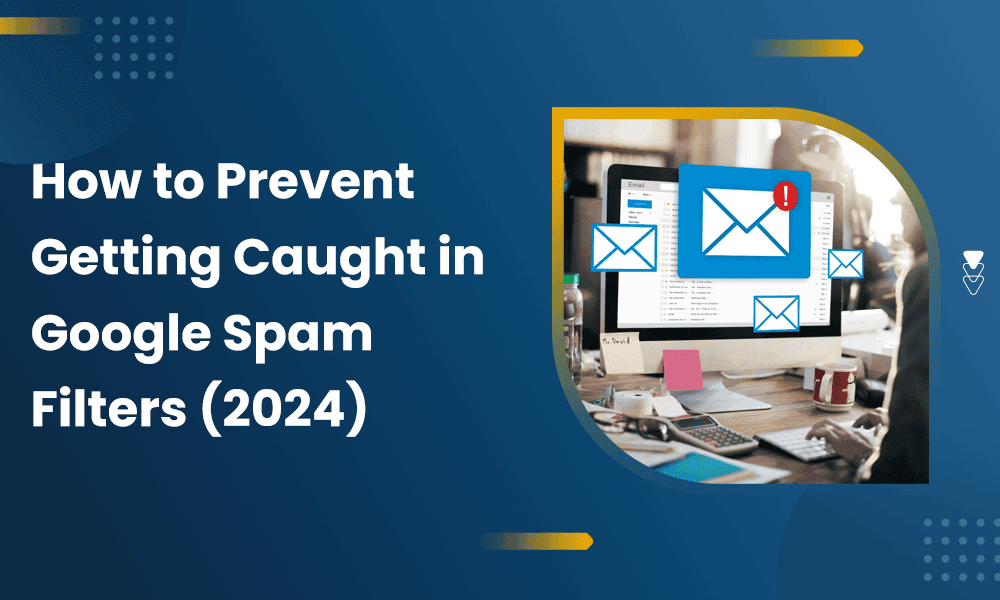Gmail is integral to our lives, especially as we check it in the morning. For small businesses, it’s a vital communication tool for sending promotional, educational, and order update emails.
Gmail’s spam filters help avoid unwanted emails, ensuring critical messages aren’t missed. With email marketing generating a staggering 4200% ROI, or $42 for every dollar invested, mastering Gmail is crucial.
With over 1.8 billion users worldwide, Gmail stands out among email service providers. However, navigating its spam filter can be tricky.
Often, promotional emails end up in the spam folder if sent too frequently or with spammy words. With 85% of daily email traffic classified as spam, how do you avoid this fate?
In this blog post, we’ll talk about Gmail spam filters, how to avoid them, and examples of good email marketing from various brands.
Let’s get started!
Table of Contents
Understanding the Gmail Spam Filter
The Gmail spam filter feature stands between your inbox and many spammy emails. Built into the Gmail app, this feature shields you from being bombarded with irrelevant and harmful spam emails.
It’s the protective shield over your Primary Gmail Inbox against emails you never asked for.
How does it work?
The spam filter thoroughly assesses every email that comes to your address. Gmail evaluates an email based on its content, source, and visuals, among other factors, to determine if it is spam.
Utilizing advanced machine learning, this feature benefits Gmail users by automatically detecting and filtering spam emails, enhancing email security, and reducing inbox clutter.
The spam filter improves digital security and time management by preventing your inbox from being crowded with unnecessary emails. However, sometimes legitimate business emails get lost in the spam filter if they use certain spammy words or are sent from an unfamiliar sender’s IP.
You can also end up in the spam folder if you send emails too frequently, overwhelming your recipients.
Gmail users can manage their spam folder by navigating to the ‘Spam’ section in the Gmail app to ensure no crucial emails are missed.
Maintaining a good reputation as a business sender is essential. Create engaging and helpful content, avoid spam-triggering words, and maintain a positive relationship with your recipients to stay out of the spam folder.
Strategies to Avoid Spam Filters
The goal is to avoid landing in the Gmail spam filter.
How do you achieve this? By meticulously planning your content, building a strong reputation, and having a robust technical setup.
Using common spam trigger words like ‘credit,’ ‘cash,’ ‘reward,’ etc., can lead to emails being flagged as spam. Let’s dive into what you can do to avoid this.

Craft valuable email content by avoiding spam trigger words
There are many ways to tip off Gmail spam filters, and using spammy content is the first one.
Google quickly identifies content that adds no value to the user. Using all caps, excessive exclamation marks, and misleading subject lines that promise too-good-to-be-true offers are just a few ways you can go wrong.
Avoiding such spammy content helps prevent your emails from being classified as spam by Gmail’s filters.
So what do you do?
Send emails with relevant content that appeals to your recipients. Personalize your content to make it valuable, appropriate, and engaging.
Understanding your subscribers’ interests, needs, and preferences is the best way to do this. Share tips or valuable insights into the problem your product or service addresses.
Personalizing your content for each recipient is crucial in any email campaign. It makes the reader feel important. Address them by name, email birthday wishes, or address their problems directly.
Leverage tools to create better emails
Ensure that words and images are appropriately combined and proportionate, especially in technology-rich content. Create a text-to-image map where the text provides background information, and the images supplement the message.
This enhances the user experience and helps prevent your emails from being filtered into the recipient’s spam folder due to excessive images.
Click’ Create filter’ in your Gmail settings to set up filters and ensure your emails are not in the spam folder.
Additionally, include a ‘text-only’ version of your email for those accessing it on older mail providers or those with visual impairments.
Some mail providers remove HTML code or elements like tables and images from the message.
Including a text version ensures your intended message gets across to the target audience, even if they’re using an email client that strips HTML code. It also gives subscribers control, allowing them to decide which emails they receive from you, improving their communication experience.
Maintain a good sender reputation
When deciding whether to place your email in the inbox or spam filter, Gmail and other inbox service providers (ISPs) primarily rely on your sender’s reputation.
Your sender’s reputation is influenced by various factors, such as email content, frequency of abuse complaints, email list quality, and sending history.
Working on these areas is crucial for building a healthy sender reputation.
Gmail’s new regulations for bulk senders enhance email security and reduce inbox spam by requiring mandatory email authentication, simplifying the unsubscription process, and enforcing a strict spam rate threshold.
The sender’s reputation comprises both IP reputation and domain reputation. Most email service providers (ESPs) provide a range of IP addresses for sending emails, each with its online reputation that informs mail servers whether or not to trust emails from that particular address.
Domain reputation is equally important.
The domain you send emails from, such as engagebay.com, determines your domain reputation. This reputation is based on the emails you send from the domain, just like your IP reputation.
Building a solid reputation takes years, but one botched email campaign can destroy it.
Ensure list hygiene
List hygiene shouldn’t be ignored if you want your email marketing efforts to yield the desired result. Removing inactive or non-responsive email addresses helps reduce unwanted messages in the inbox.
That’s why we’ve listed out the best practices for you to ensure that your email list hygiene is maintained:
- Regular Cleaning: Keep updating the list to weed out inactive or non-responsive email addresses from the list to keep your bounce rates accurate.
- Double Opt-In Process: include a CTA or any other confirmation method, such as a poll or a reply, to see if your recipients actively engage with your content.
- Easy Unsubscribe Option: Nobody wants to go through the trouble of contacting the sender to stop sending mail. That’s why you need to put an Unsubscribe option in your mail to give your recipients an easy way out.
- Honor Opt-Out Requests Promptly: Once a recipient has shown their decision by unsubscribing, they cannot send an email again. This helps you command a good sender’s reputation.
Build a robust technical setup
Building a sound technical setup is crucial if you want your emails to be sent from an authentic IP address with quality deliverability and not end up strangled in the spam filter. Here are the technical aspects to keep in mind:
- SPF (Sender Policy Framework): ensures that the domain sending a particular email is from an authentic source.
- DKIM (DomainKeys Identified Mail): Makes your emails unique and identifiable by adding a digital markup to your emails.
- DMARC (Domain-based Message Authentication, Reporting, and Conformance): This protocol saves you from threats such as phishing attacks, spam, or fraudulent emails.
Setting up SPF, DKIM, and DMARC can help trusted senders bypass spam filters and ensure their emails reach the inbox.
Together, SPF, DKIM, and DMARC form the infamous tripod of the internet protocol. They can ensure you don’t end up in Gmail’s spam filter when put in effect in tandem.
Read also: 41 Gmail Tips and Tricks for a More Productive 2024
How to Monitor and Manage Email Deliverability
As a result of the factors mentioned above, controlling and monitoring various elements of email deliverability are essential to achieve successful campaigns and stay out of the spam folder.
Monitoring and managing these aspects also help improve spam filtering by ensuring legitimate emails reach the inbox.
Here’s a guide on how to do so:
- It is necessary to monitor our IP addresses and the domains on the blacklist level to maintain a good sender reputation and to prevent utilizing dismal blocklists.
- Real-time analytics are great to use when delivery issues have to be identified and eliminated immediately. For instance, if one day there is a sharp rise in complaints concerning spam emails or a drop in email utilization, the user will be alerted at the right time to address the issue.
- Familiarity with bounce rates and measures to avoid them also helps monitor email delivery. An email bounce is when an email message is returned to the sender because it was impossible to deliver to the recipient’s mailbox.
- Improve your email marketing by tracking open rates and click-throughs. You want a high open rate (the proportion of persons who received and opened your email) and a strong click-through rate (CTR). A high open rate and CTR indicate you accomplished attractive and appealing advertising.
- Monitor and control spam complaint rates regularly to avoid the Gmail spam filters. When subscribers click the “Report Spam“ button, they notify their email service provider that they do not want to receive spam.
- Keep an eye on feedback loops with prominent ISPs. One type of feedback email service provider offers is called a Feedback Loop (FBL). It enhances email deliverability by enabling the email sender to take corrective action and prevent more spam complaints.
Read also: What Is Domain Reputation and How Can You Improve It?
Examples of Successful Brands That Passed Gmail Spam Filter
Many small businesses fall prey to Gmail’s spam filter, and it’s nothing new. This often happens when the parameters for email deliverability aren’t followed diligently.
However, various businesses have scaled their ROIs by following proper methods. One effective strategy is creating custom Gmail spam filters to manage email deliverability better.
Let’s discuss in detail how to do this.
Birdies: email marketing automation

Birdies is a leader in making fashionable, durable, and comfort-oriented shoes. Recently, it adapted to email marketing, and its methods showed an open rate of 11% and a conversion rate of 16%. But this didn’t happen overnight!
They did it with a meticulous email marketing campaign plan that is automated and on-point regarding deliverability. To ensure their automated emails did not end up in the spam folder, Birdies used the ‘create filter’ option in Gmail.
This gave them the vantage point to evaluate the nature of different segments of their consumer base. Who would spend more? Who would leave? And who prioritizes comfort and style over price?
This data could nurture the leads, engage everyone on the mailing list rapidly, and target the content and message of the emails that the marketing team desires to send. For instance, Birdies claims that introducing incentives such as a $20 discount to consumers to persuade them to recommend friends effectively retained customers.
Outcome
Email automation is very beneficial because it allows you to respond to leads or customers faster while completing tasks in a shorter amount of time, thus leading to higher conversion rates from leads.
Make sure to check the analytics associated with email marketing frequently. Monitor your unsubscribe, click-through, and open rates to know what to send and what not to send to your audience.
Ambition: Follow-up emails
Ambition is a software that assists companies in increasing employee productivity. Renowned firms such as Continuum, Carbonite, and Lyft employ the technology created with millennial employees in mind.
For one of their marketing campaigns, they initially cold-emailed 578 prospects and got six responses. They then followed up and got an additional 67 hot leads.
Outcome
The key takeaway from their email campaign is that persistence pays off. Despite initial low engagement, continuous follow-ups led to many positive responses.
The timing and message content are crucial; adjusting these factors can enhance the effectiveness of an outreach. The campaign affirmed that prospects respect persistence, supporting the adage that it takes seven touches to get through to a prospect.
Copa Airlines
Copa Airlines, based in Panama, is Latin America’s leading freight and passenger airline. The company intended to make user connection and participation more efficient when adding new emails and continuing current marketing activities.
Many contacts in the airline’s extensive database were inactive for quite a long time, and their interactions influenced the brand’s KPIs.
This created higher costs per send because unengaged contacts were costly, yet they did not spur ticket sales. Copa Airlines devised a cleanup process to overcome this challenge, which only sent emails to active customers and deleted other accounts.
Additionally, they managed their email list carefully to avoid ending up in Gmail’s spam list by using Gmail’s filter and blocked address functions.
Specifically, Copa Airlines attained several positive results regarding the company’s email marketing campaigns. Their revenues went up by 14%. The conversion rate grew from 8% to 10%. And the companies’ open rates rose from 15% to 17%. They received 10% fewer emails yet had twice the return in their ROI and an 11% downtrend in unsubscribes.
Outcome
If you use or maintain an email list, it is probably time to update it. True inactive subscribers on the mailing list also hamper email delivery, make list management expensive, and increase the probability of emails going into the spam folder.
Additionally, make your email marketing unique and use email campaigns for remarketing. Discounts and customized product suggestions are examples of relevant offerings.
Read also: Everything You Need to Know About Email Subdomains
Conclusion
Gmail’s spam filter is essential for managing emails but poses challenges for businesses aiming to reach their audience.
Businesses can enhance email deliverability by understanding how the filter works, avoiding spammy content, maintaining a good sender reputation, and employing robust technical setups. Examples from Birdies, Ambition, and Copa Airlines highlight successful strategies to bypass spam filters.
Regularly monitoring email deliverability and keeping a clean email list are critical practices. Implement these strategies to ensure your promotional emails land in the inbox, maximizing your marketing ROI.
EngageBay is an all-in-one marketing, sales, and customer support software for small businesses, startups, and solopreneurs. You get email marketing, marketing automation, landing page and email templates, segmentation and personalization, sales pipelines, live chat, and more.
Sign up for free with EngageBay or book a demo with our experts.
Frequently Asked Questions (FAQ)
1. How can I check if my Gmail emails will be spam?
To check if your emails are going to spam in Gmail, use a tool like Mail Genius or Mail Tester to identify technical issues with your email deliverability.
2. What are the most common reasons emails are in Gmail’s spam folder?
Some of the reasons are:
- The issue with the authentication of your email.
- The reputation of your transmitting IP is not good.
- Your domain needs to be more well-known.
- Your emails were flagged as spam by your receivers.
- You don’t maintain an organized email list.
- Someone is abusing your forms.
3. How do I access and manage the Gmail spam folder?
To access the Gmail spam folder, open Gmail and look for the “More” option on the left sidebar. Click on it, and then select “Spam.”
Here, you can review the emails that Gmail has marked as spam.
If you find an important email, select it and click “Not spam” to move it to your inbox. Regularly check the Gmail spam folder to ensure you get all the important emails.
4. How often should I clean my email list to maintain a good sender reputation?
Quarterly: It’s the usual practice to clean your email list every three months.
5. Can changing my email service provider affect how often I get flagged as spam by Gmail?
Yes, changing your email service provider can impact how often Gmail flags you as spam. A reputable provider with strong deliverability practices can help improve your sender reputation and reduce spam flags.
6. What steps should I take if Gmail wrongly blocks my domain?
Removing your domain or IP address from those blocklists may be as easy as contacting the owner and requesting them to remove it.
The leading blocklist companies provide information on their websites on how to get them to remove you from their lists.
7. Can I directly communicate with Gmail about my emails being marked as spam?
You can contact Gmail’s Postmaster Tools or support to address issues with your emails ending up in the spam folder. Provide details about your email practices for assistance and review.
